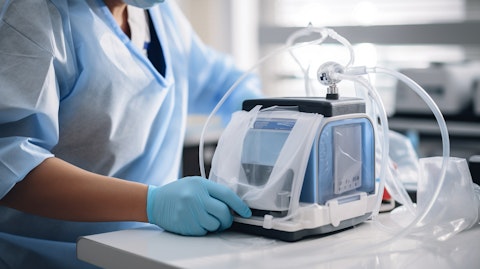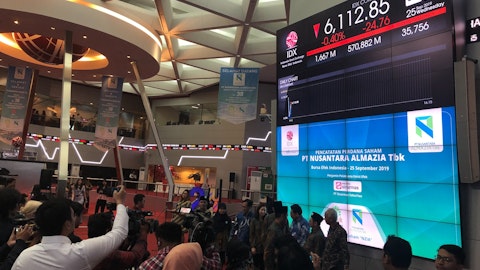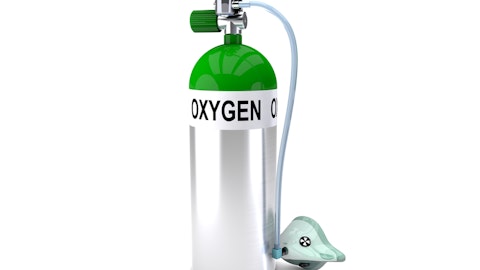Inogen, Inc. (NASDAQ:INGN) Q3 2023 Earnings Call Transcript November 7, 2023
Inogen, Inc. misses on earnings expectations. Reported EPS is $-1.97 EPS, expectations were $-0.57.
Operator: Greetings, and welcome to the Inogen 2023 Third Quarter Financial Results Conference Call. [Operator Instructions] And as a reminder, this conference is being recorded. It is now my pleasure to introduce to you, Marissa Bych from Gilmartin Group. Thank you, Marissa. You may begin.
Marissa Bych: Great, thank you. And thank you all for joining today’s call. Joining me are President and CEO, Nabil Shabshab; and Interim CFO, Mike Sergesketter. Earlier today, Inogen released financial results for the third quarter of 2023. The earnings release is available on the Investor Relations section of the company’s website, along with the supplemental financial package. As a reminder, the information presented today will include forward-looking statements, including without limitation, statements about our growth prospects and strategy for 2023 and beyond, expectations related to our financial results for 2023, expectations regarding increasing productivity of our internal and external sales teams, progress of our strategic initiatives, including innovation, our expectations regarding the market for our products, our business and supply and demand for our products in both the short and long term.
The forward-looking statements in this call are based on information currently available to us as of today’s date, November 7, 2023. These forward-looking statements are only predictions and involve risks and uncertainties that are set forth in more detail in our most recent periodic reports filed with the Securities and Exchange Commission. Actual results may vary, and we disclaim any obligation to update these forward-looking statements, except as may be required by law. We have posted historical financial statements and our investor presentations in the Investor Relations section of the company’s website. Please refer to these files for more detailed information. During the call, we will also present certain financial information on a non-GAAP basis.
Management believes that non-GAAP financial measures taken in conjunction with U.S. GAAP financial measures, provide useful information for both management and investors by excluding certain noncash items and other expenses that are not indicative of Inogen’s core operating results. Management uses non-GAAP measures internally to understand, manage and evaluate our business and make operating decisions. Reconciliations between U.S. GAAP and non-GAAP results are presented in tables within our earnings release. With that, I will turn the call over to Inogen’s President and CEO, Nabil Shabshab.
Nabil Shabshab: Thank you, Marissa. Good afternoon and thank you for joining our third quarter 2023 conference call. During today’s call, I will discuss our performance in the quarter, our progress across our business initiatives and our outlook for the rest of the year. Then Mike Sergesketter, our CFO, will walk through more details of our financial performance and our annual guidance before we take questions. We recognized $84 million in total revenue in the third quarter while continuing to address some lingering headwinds to our business. Despite the typical third quarter seasonality, we grew total revenue by 40 basis points in the third quarter versus the second quarter. Starting with our direct-to-consumer business. In the third quarter, we recognized $25.1 million in DTC revenue as a result of strong revenue per sales rep, offset by fewer total reps as we continue to optimize the size of our team and focus on sales rep productivity.
We are continuing to drive efficiency in this channel and our productivity per rep, both in units and revenue was up double digits on a year-over-year basis. Turning to our domestic B2B business. We recognized revenue of $17.3 million, which was impacted by residual headwinds to our business from the share loss we experienced over the past year due to the 2022 supply chain-related volume constraints and lower price competition. In the third quarter, we made progress in recapturing market share while diversifying our customer base. In our international B2B business, we recognized $25.6 million in revenue, reflecting strong double-digit growth on a year-over-year and sequential basis. While we witnessed a significant delay in the Rove 6 French reimbursement approval, we did secure reimbursement in August, and we are currently focused on introducing Rove 6 to key customers in that market.
Please note that although our third quarter was relatively strong, we expect a lighter fourth quarter in the international B2B channel with sales expected to be roughly flat year-over-year as we work through the Rove 6 introductions in France. Our rental revenue was $16 million, increasing both year-over-year and sequentially. Rental revenue continues to benefit from improved prescriber team productivity with increases in referrals per sales rep as compared to Q2. We expect continued steady progress as we further optimize sales territories and core frequency to drive scale and number of prescriptions per prescriber and overall growth. Shifting gears to our efforts to improve our cost structure and our operating efficiency. Mike will provide additional details on our operating expenses, but in short, we saw an increase in operating expenses in the quarter, primarily due to a noncash impairment charges related to the write-down of goodwill.

Our adjusted operating expenses fell to $47.6 million in the quarter, a decrease of $5.5 million year-over-year. This was primarily due to our initiatives to optimize productivity of our sales organization while managing marketing spend. Before I turn the call over to Mike, I’d like to highlight that we are very excited to have closed our acquisition of Physio-Assist during the quarter. Physio-Assist expands our innovative respiratory portfolio with the addition of Simeox, a technology-enabled airway clearance and mucus management device predominantly aimed at treating bronchiectasis. Entering the adjacent airway clearance market provides us the opportunity to serve patients earlier in the disease journey, expanding their lifetime value for Inogen and standing up a business model that delivers a recurring revenue stream from consumables.
We did not recognize any revenue from Simeox in the third quarter and consistent with our expectations at the time of acquisition, we do not expect any material revenue from the acquisition this year. I will now turn the call over to Mike for a review of our financial results. Mike?
Mike Sergesketter: Thank you, Nabil, and good afternoon, everyone. Unless otherwise noted, all financial comparisons are to the prior year comparable periods. Total revenue for the third quarter of 2023 was $84 million, a decrease of 20.3% versus the prior period. The decrease was driven by lower direct-to-consumer and domestic business-to-business sales, partially offset by increased rental and international B2B sales. For the third quarter, foreign exchange had a negative 120-basis point impact on total revenue and a negative 790-basis point impact on international revenue. Looking at third quarter revenue on a more detailed basis. Direct-to-consumer sales decreased 24.1% to $25.1 million in the third quarter of 2023 from $33 million in the prior period, driven primarily by lower sales volume due to fewer sales representatives and lower marketing spend as we continue to drive towards improved sales rep productivity and overall channel profitability.
Domestic business-to-business revenue decreased 59.4% to $17.3 million in the third quarter of 2023 compared with $42.5 million in the comparable period. Please note that our year ago B2B revenue had benefited considerably from pent-up demand and the fulfillment of backlogged orders in the channel. International business-to-business revenue increased 69.9% to $25.6 million in the third quarter of 2023 as compared to $15.1 million in the prior period. Rental revenue increased 8.7% to $16 million in the third quarter of 2023 from $14.7 million in the prior period. Growth was driven primarily by an increase in the total number of rental patients on service. Now to discuss our gross margins. Total gross margin was 40.2% in the third quarter, declining 40 basis points from the prior period, primarily driven by higher warranty costs and partially offset by lower consumption of premium-priced components.
Sales revenue gross margin was 37.2%, driven primarily by a shift in channel mix with the lower volume of units sold through the direct-to-consumer channel as well as an impact from pricing pressure in the business-to-business channels. Rental revenue gross margin was 53.1% primarily due to increased rental revenue adjustments and higher servicing cost per patients on service, partially offset by higher Medicare reimbursement rates. Please note that we continue to carry inventory of premium price components for semiconductor chips on our balance sheet as on-hand inventory. As of September 30, 2023, the value of premium components in our inventory balance was $4.8 million. Due to lower forecasted sales volumes, we now expect the cost for premium-priced components to continue to impact cost of goods sold at a declining rate through the first half of 2024.
Moving on to operating expense. In Q3, total operating expense increased to $80.5 million compared to $53.1 million in the prior period, representing an increase of 51.6%. The increase in expense is almost exclusively the result of onetime $32.9 million impairment charges. As previously mentioned, we incurred the $32.9 million of impairment charges. This is a noncash expense that has no impact on the company’s cash balance or business operations. Excluding the onetime charges, operating expense decreased to $47.6 million, representing a reduction of 10.4% as compared to the prior period. Going into more detail on our expenses in the third quarter, we have continued to work on our innovation pipeline through investment in research and development with a total spend for the quarter of $4.5 million.
This spend was in line with the third quarter of 2022. Sales and marketing expense in the period was $26.1 million, representing a 22.7% decrease from prior year. The $7.6 million reduction in spending was primarily driven by lower personnel-related and media and advertising costs associated with our direct-to-consumer channel. And finally, we incurred costs of $17 million for our general and administrative expenses in Q3, representing a $2.2 million increase as compared to the prior period. The increase was primarily attributable to $1.4 million in restructuring-related costs as well as $1 million of acquisition-related costs. In the third quarter of 2023, we reported a net loss of $45.7 million and a loss per diluted share of $1.97. On an adjusted basis, we reported a net loss of $8.5 million and an adjusted loss per diluted share of $0.36.
Adjusted EBITDA was a loss of $5.5 million. Moving on to our balance sheet. As of September 30, 2023, and after closing the Physio-Assist deal, we had cash, cash equivalents and marketable securities of $138 million with no debt outstanding. I will now turn to our financial outlook. We continue to expect total company revenues for the full year 2023 to be in the range of $315 million to $320 million. We now expect an adjusted EBITDA loss of approximately $27 million for the full year, inclusive of investments in our Simeox airway clearance portfolio, which we acquired through the Physio-Assist transaction. And with that, we’ll be happy to take your questions.
See also 10 Best Big Name Stocks to Buy Now and 14 Best Annual Dividend Stocks To Buy Now.
Q&A Session
Follow Inogen Inc (NASDAQ:INGN)
Follow Inogen Inc (NASDAQ:INGN)
Operator: [Operator Instructions] And the first question comes from the line of Mathew Blackman with Stifel.
Colin Clark: This is Colin on for Matt. I wanted to start with the DTC franchise for a moment. I understand the sales force productivity and the hiring efforts are still ramping and we’re still dealing with tough comps from a footprint standpoint. But I’m curious when we’ll start seeing any inflection in the DTC revenue line from the recent changes you’ve implemented to increase the headcount and efficiency. Could this be a 2024 event or a 2025 event? Any color there would be helpful.
Nabil Shabshab: Colin, it’s Nabil. I’ll take that question. Thank you for the inquiry. So with respect to DTC, we are happy to continue to drive productivity per sales rep, both in revenue as well as in units. And as we had communicated on earlier calls, we’re using this opportunity in 2023 to set up for a more productive 2024 performance in terms of both continuing to drive the productivity per rep as well as getting to the right number of people in the seats that are productive, so we can get the overall growth.
Colin Clark: Okay. Understood. If I could ask one on the rental side. The rental business and your prescriber channel strategy in general, seemingly continues to be a highlight for you guys. So I was wondering if there’s been any cannibalization of the DTC business as of yet? And if not, what revenue run rate would the rental business have any effect on your new patient acquisitions downstream in the DTC side of things?
Nabil Shabshab: Yes. That’s a good question, Colin. So let me maybe just depict the journey in terms of the buying process that these patients go through. When we go to the rental prescriber, we intended to go upstream, whereby we secure that prescription from the actual physician or the prescriber, and we sell it as an HME or DME ourselves. Typically, our downstream, which is the direct-to-consumer cash sales, are patients that have gone through that journey and are dissatisfied with the devices they’re on, and they’re not covered anymore by insurance, hence, they’re willing to actually pay for the device for cash. And in general, there is no overall cannibalization that is material. If you capture them upstream a little bit earlier and put them on the right device in rental, there could be a slight impact on downstream.
But typically, the DTC patients are ones that have run out of options and coverage. So they’re not really the same patients, and that’s why we can sell them on cash because that’s the only option left for them. If they want to get on the latest technology, a new device and they have no other option there.
Operator: And the next question comes from the line of Margaret Kaczor with William Blair.
Margaret Kaczor: Maybe just to start, I’m not sure I heard in the intro comments, whether or not you guys are seeing any kind of a macro impact, whether it’s on DTC or B2B domestic. Now, is it all harder for folks to get financing? Is there any kind of change in friction or it’s more of the commercial dynamics with the sales force and so on?
Nabil Shabshab: Thanks for the question. So you’re right, we didn’t actually go into the details. We said we are dealing with some lingering headwinds that are in the B2B business. And there are — as you characterize them, there is still an overhang in terms of access to capital in some instances or the cost of borrowing with some customers. What we’re doing is we’re working there. And then, of course, people are looking for margin accretion in their own businesses. So we’re working very diligently to actually continue to put forth a value proposition that we believe is resonating with these types of customers in terms of our total cost of ownership versus an acquisition price head-to-head whereby as we operate that asset and generate revenue from it.


